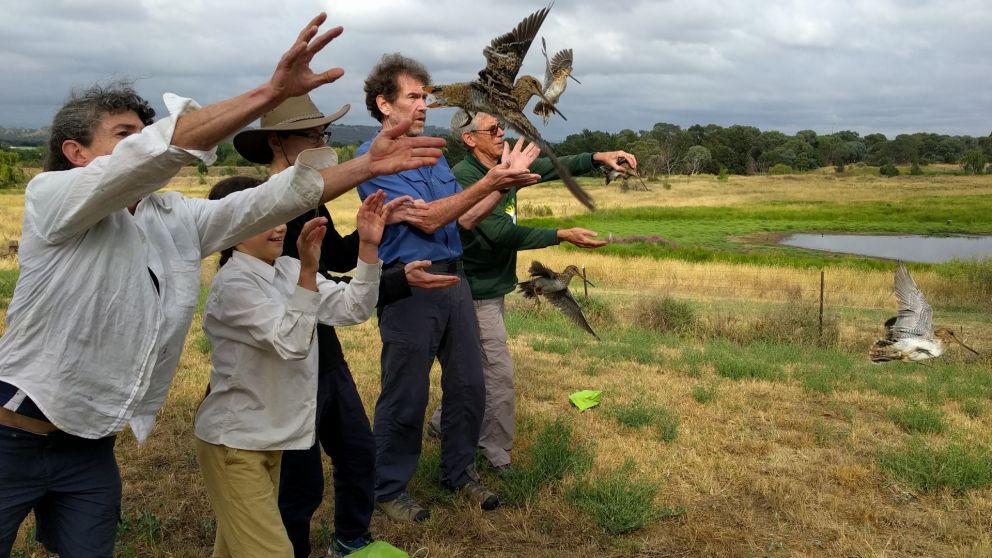Researchers and volunteers join forces to help protect the Latham’s snipe
3 April 2020

Researchers are tapping into the power of citizen science to study the Latham’s snipe, a migratory shorebird that breeds in Japan during the Australian winter and migrates to south-eastern Australia in spring.
The project, led by Dr Birgita Hansen, Senior Research Fellow at Federation University Australia’s Centre for eResearch and Digital Innovation, is collecting information about the ecology, wetland use and migration strategies of the species, whose numbers have been dropping on breeding grounds in Japan.
The shy, medium-sized snipe are generally widely dispersed in low numbers across wetland and grassland areas, and prefer to roost in grass and weeds close to water during the day. At night they disperse to feed in nearby wet paddocks and other open flooded areas. The birds were hunted in Australia until the early 1980s. Now, loss of habitat through development and conversion of wetlands to agriculture have become their biggest threats, with more than 70 per cent of wetlands across their south-east Australian range disappearing within the last 100 years.
Latham’s snipe is one of 37 migratory species listed under the Commonwealth Environment Protection and Biodiversity Conservation Act 1999. A key component of the project is monitoring across eastern Australia, carried out during the non-breeding season to establish population sizes and to identify characteristics that define important habitats. Habitats that support 18 or more birds are considered sites of national importance under the act and development proposals which might impact these sites require referral to the Federal Environment Minister.
The project got its start after a development application at Port Fairy in Victoria’s south-west.
“It began as a legal case, which is an unusual way to start a research project, and from that we started monitoring the species in the area. More people were getting interested and getting involved so we started monitoring other places around the state and moved the monitoring interstate because the species occurs throughout the eastern states of Australia,” Dr Hansen said.
“We then started working with Japanese researchers, carrying out some capture-based works to look at the snipe’s migration.”
The birds arrive in Australia in August and September, spending their non-breeding period in the summer warmth of the south-eastern states before the migration north begins in February. The last birds leave northern Australia in May.
Snipe have been tagged with tracking devices to collect migration data and identify, protect and manage their stopover sites. In 2016, one bird was tracked from Japan to Australia non-stop across the Pacific Ocean in three days, a distance of about 7000km – one of the fastest migrations on record for any bird.
“This particular bird was much faster than we would have expected and it may have had a weather system behind it, but they're part of a group of birds that have extreme stamina and endurance and can do these extreme flights – in this instance it would have been an average speed of just over 95 kilometres per hour,” Dr Hansen said.
Recent tracking data has indicated that snipe stopover on northward migration for up to two months in northern New South Wales and in south eastern and central Queensland. They also use the highlands of Papua New Guinea on migration to and from Japan, although it is not known how many birds stop here and what their preferred habitats are like.
Dr Hansen said determining where the snipe go and why they choose specific locations was critical so these sites can be better protected or managed.
“We’re also engaging with the communities where we work to encourage ownership and protection of the local environment that the snipe rely on.”Dr Birgita Hansen
Up to 250 volunteers play a leading role in population monitoring, with detailed information about the distribution and abundance of the species having been collected since 2015. Surveys are conducted three times a season at about 200 sites, with the monitoring so far yielding more than 50 sites that have nationally important numbers of snipe. The project is the only targeted monitoring for Latham’s snipe in the country.
“Volunteers – the citizen scientists – have been a critical part of this project and much of it would have been impossible to achieve without this important contribution from so many people,” Dr Hansen said.
“The project has been fortunate to receive financial support from the Australia Japan Foundation and the ACT Government, the latter through the project’s key partner, the Woodlands and Wetlands Trust.”


